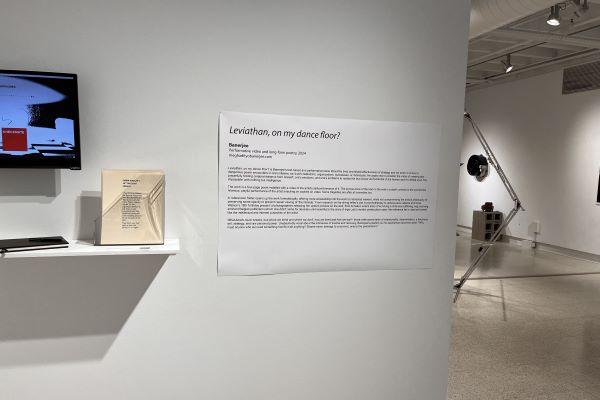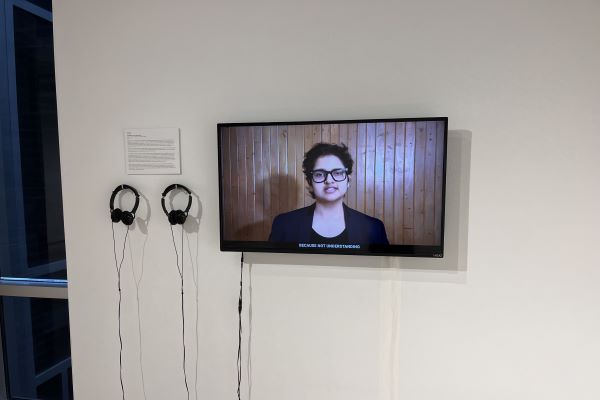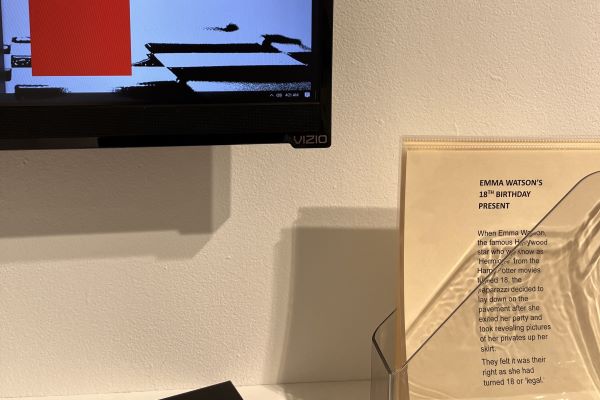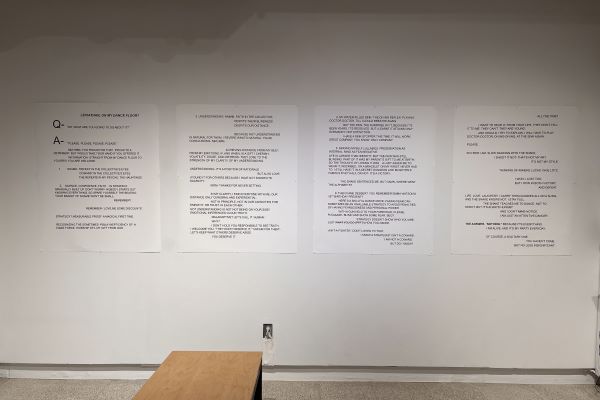Artist Interview with Banerjee: “Leviathan, on my dance floor?”

Convergence is the current exhibition on view at Hopkins Hall Gallery, with pieces made by nine first-year MFA students. The exhibition focuses on how people with different backgrounds and perspectives can come together and meet at a certain point. Convergence is on view until February 9, 2024.
“Leviathan, on my dance floor?” is a performance and textual poetry piece by artist Banerjee. In this interview, Banerjee answers questions about his piece, including its relation to facing powerful institutions and to the Convergence exhibition as a whole.
1. How was the title, Convergence, created? And how does “Leviathan, on my dance floor?” relate to the show’s title?
The Cambridge dictionary defines convergence as “moving towards the same point and coming closer together or meeting.” Our graduate exhibit is all about that—people with diverse backgrounds, worldviews, philosophies of art, and apparently disparate ways of processing and responding to the world around them—coming together at a single point. Each of the nine participating artists may envision this point of convergence in a very personal way, and yet we all unite in our desire to create a meaningful impact in the world we inhabit by being active artist-thinkers who are committed to encouraging important discourse. Thinkers are “doers” too, even if that is not easily grasped—thinkers are quiet, powerful, assertive, active doers.
Each of us have tried our best to create works that are impactful, either by bringing forth our personal truths or perhaps larger social/relational truths. Expression and honesty in art isn’t about self-indulgence or wallowing in emotion—it is about recognizing the power we have as artist-thinkers to bring attention to and set forth in motion crucial, timely, and intellectual discourses that may change the course of our personal lives or that of the collective.
“Leviathan, on my dance floor?” highlights the effectiveness of strategy and cerebral thinking when it comes to facing dangerous “leviathans” or power institutions in our life. Unlike more affective or emotive works, this piece tries to draw attention to how rationally incisive cerebral thinking and strategy are a product of thoughtfulness, and thoughtfulness is rarely divorced from compassion and empathy, and how cerebral, detached ways of observing and processing our experiences can help us triumph over our most difficult times. It is all about focusing on “the internal locus of control” and realizing that even when we are at the mercy of those who use power for unethical, brutal purposes, we have the power to change that narrative.
2. How did your peers inspire you when creating work for the show?
My fellow peers were working in different ways to create and install their works, and we have had a very collaborative journey. Some of them were working with sound and motion sensors, others with public engagement around political issues, and yet others with personal themes and passions. We encouraged each other throughout the making of our works by celebrating each other’s individual strengths, and that was a real gift. I appreciate the immersive, emotional affect some of the works have, and they appreciate my cerebral way of dissecting and analyzing things.

3. “Leviathan, on my dance floor?” has both a text and a performance aspect. Why did you choose to have both, and what does each part bring to the entire piece?
The text-based, long-form poetry version of “Leviathan, on my dance floor?” acknowledges the seriousness of the trauma that people endure from those in positions of power who use it for unethical, brutal motivations. The tone is serious, contemplative, incisive, strategic, honest, and sometimes poignant. The performative aspect of the piece is actually a real, tangible act of “reclaiming personal power” from those who brutalize us, and it does this with something as unexpected as humor. Humor can be a powerful instrument for renegotiating and rewriting power narratives of any kind. When I appear on screen casually snacking on cookies while talking about Emma Watson’s “18th birthday present,” which refers to the event of paparazzi releasing upskirt pictures of her on the web to harass her, it makes a complete joke out of that act of brutality. It makes the act and the perpetrators lose all perceived sense of “power.” Laughing at someone’s brutalities is a way of reminding them that what they do makes them look like kids. And would they even be worth confronting or taking seriously if we see them as children?
The humor isn't meant to minimize the seriousness of traumatic experiences or to deflect from them through some unhealthy coping strategies—that is why the vulnerability and the honesty of the text next to the performance is extremely important. Works in which we have the courage to cry but also laugh can help us be truthful and powerful at the same time. It may seem like a contradiction, but as humans, having multiple perspectives on the same situation or experience is a power we hold.
4. What do you listen to when brainstorming and/or creating?
I am an active thinker and reader, and my mind is usually running much faster than I can keep up with. I am not a social media person much, but I do greatly enjoy being on Reddit and reading voraciously on the different subreddits on the platform. It is a secret guilty pleasure of mine. I also enjoy reading about Jungian Typology and Enneagram Tritypes. I have always taken great interest in people and interpersonal relationships, so these have always interested me. Reading and interpersonal conversations get me more in the creative space than music does.

5. Your piece includes a physical reference folder—a unique element to the piece that gives viewers more background understanding of your work. What was your thought process behind adding these references?
I often work with deeply intimate, personal experiences in my life, but I am also a private person. Opacity is an important part of my work—I often talk about very personal things without giving away too many personal details from my own life. My works are usually ones that reveal themselves slowly over time, over repeated readings, rather than in a single one-time interaction in a gallery space. They can be rather cerebral and abstract and require a certain mental bandwidth to sit with and process—that is a reason I often have a QR code for people to return to the work again later, on my site, when they have the leisure or interest to do so. Otherwise, it would feel very rushed.
As an artist, I have always felt that “the intimate/personal” is something I wish to “protect from casual viewing.” In simple words, it means I don't want someone to access a personal experience in my art if they are viewing it casually and not spending a certain amount of time or attention with it. I may be willing to share that vulnerability with viewers who spend fifteen to twenty minutes with the work, and so my work becomes more accessible as one spends more time with it. I also understand that people of different temperaments, different habits of technology, and different generations come into a gallery space. And it would be rather haughty of me to assume that someone who isn't googling a reference in my poem doesn't want to spend time with it or dive deeper.
So, my “references folder” in a gallery is like a deep internet search of sorts, giving someone knowledge of the complex references in my work so it becomes accessible. While “Emma Watson’s 18th birthday” may give you some relevant results from Google, googling “diving reflex” will lead you to the biological/evolutionary background or definitions. Using a reference sheet lets me share my knowledge of it in the specific context of its research in psychotherapy—i.e., its use in reducing panic attacks. So, without context, a Google search about a certain term will not necessarily lead you to the information I am alluding to in a work. The references folder helps provide the right context about the reference I am using.

6. What is the main message you hope viewers will take away from your piece and the exhibition as a whole?
The message we hope viewers will take from the exhibit is the power we have as individuals to change the course of our individual lives and the direction in which society is headed by choosing to actively engage in important discourse, and communicating about important issues—personal and social—and not being scared to voice our individual opinions and positions if they are seen as “controversial.” Just as communication is seen as one of the key elements of a successful intimate relationship, communication or “self-expression” through art is a key element in beginning important conversations among us, whether they are comfortable or not, and to realize how much impact we actually have as individuals in the world we live when we actively choose to be brave and authentic.
